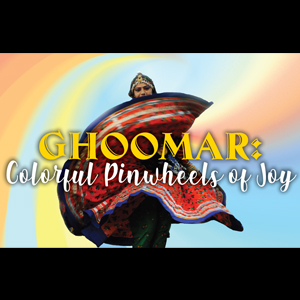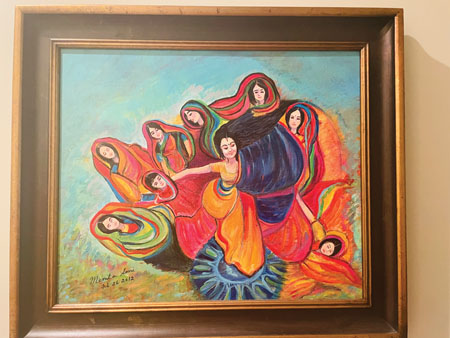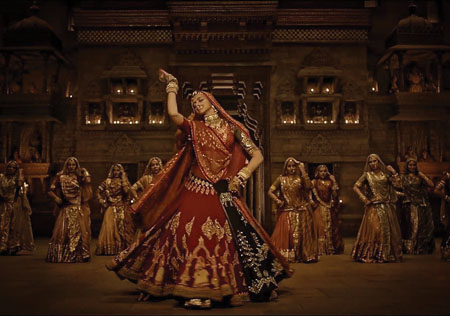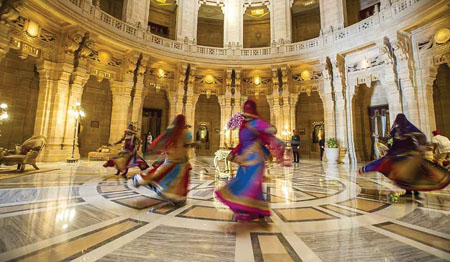Arts: Ghoomar: Colorful Pinwheels of Joy

Bollywood may not be the first thing that comes to mind when thinking about the artistry and aesthetics of the many exquisite regional folk dances of India. But to their credit, these movies have popularized regional folk dances to national and international audiences—even when not always representing them in their most authentic forms.
Mission Kashmir gave us Kashmir’s rouf dance while Chennai Express gave us a frivolous filmy peek at Kerala’s kathakali. In Ramleela’s massively popular Nagada Sang Dhol, heartthrobs Ranveer Singh and Deepika Padukone made the Gujarati garba sizzle with romantic flamboyance. And then came the magnum opus Padmavat in which Rajasthan’s ghoomar was showcased in extravagant sets with massive star power (Deepika Padukone, again!) and luxuriant music composed by Sanjay Leela Bhansali.
[Bottom] Painting of women performing ghoomar by Monita Soni

While I have enjoyed the filmy ghoomar for its larger-than-life allure, I have even fonder memories of its authentic expressions in Rajasthan. Having lived there for over a decade, I remember several live performances. A sweet memory of this folk dance emerges like baby fingers through soft silt: something precious and cherished; twirling with mystery, magic and magnificence.
It was the annual day function at my son’s school at St. Anselm’s in Malviya Nagar, Jaipur. The teachers opened the celebration with a traditional ghoomar. No sooner did the folk lyrics “O Mhaari Ghoomar che Nakhrali ye Maa” came on the speakers, my two-year-old daughter started dancing in her seat. Then she ran to the front of the stage and started spinning. She had the entire audience enthralled by her footwork as she moved to the sonorous melody of bansuri and sarangi. The beat of jhaanjar and tabla was in her blood.
O Mhaari Ghoomar che Nakhrali ye Maa
Ghoomar Ramwa Mein Jaasyan
Ohh Rajri Ghoomar Ramba Mein Jaasyan
O Mhaari Ghoomar che Nakhrali ye Maa
O Mhaane Ramta ne Kaajal Tiki Lyado ye Maa
O Mhaane Ramta ne Kaajal Tiki Lyado ye Maa
Ghoomar Ramba Mein Jaasyan
O Rajri Ghoomar Ramba Mein Jaasyan
O Mhaane Ramta ne Ladudo Lyado ye Maa
O Mhaane Ramta ne Ladudo Lyado ye Maa
(A young girl is giving her mother a long list of accessories so that she can get decked up for her first ghoomar)

Historically, ghoomar is performed as an offering to Goddess Saraswati—the goddess of universal intelligence, arts, and cultural fulfillment—by women from the Bheel community. This Indo-Aryan tribe of bow-and-arrow wielding hunters was advanced in its understanding of the scriptures. The Bheel tribe spread from Rajasthan to Gujarat, Madhya Pradesh, Chhattisgarh, Maharashtra and Deccan regions. Their Pithora art, armaments, strategy and dance were embraced by indigenous communities of Rajputs and Rathores.
[Top] In the magnum opus Padmavat, ghoomar was showcased in extravagant sets with massive star power (Deepika Padukone, again!) and luxuriant music composed by Sanjay Leela Bhansali.
Ghoomar became popular at birth celebrations and marriage functions. When young girls come of age, their mothers and aunts decorate them with ornaments: hansli (necklaces), rings, zele-zumke (earrings), narniyan (bangles), nathni (nose-rings) and tattoos. They are thrilled at the finery of brand-new georgette ghagras and thin muslin chunaris embellished with delicate gota applique and badla work. Standing still, these beautifully adorned girls look like graceful conflowers. When they dance, their footwork is soft and close to the ground. They don’t jump but seem to float in circular formations.
A fresh memory of ghoomar is from my recent visit to Rajasthan. Before the pandemic, we visited the Umaid Bhavan Palace hotel in Jodhpur on the festival of Hartalika Teej. The impressive courtyard was decorated with a large floral rangoli of roses, mogra, marigolds and lilies. The fragrance and artistic details were exquisite. We were reveling in the gaiety, enjoying an array of delectable rajbhog, rasmalai and kulfi. Artists were playing an evocative folk song on their sarangi, kamaicha and morband. Strains of “Kesariya Balma, Padharo Mhaare Des” wafted in the air. Soft banter and laughter of loved ones echoed in the notes of the song.
Our joy knew no bounds when a bevy of young performers dressed in rainbow colored leheriyas poured into the courtyard. Pink, red, magenta, orange and yellow (Dark colors like navy and black are considered inauspicious and avoided at festivities). The ladies were decked in faux ivory choodas (bangles) on their arms as shimmering long tassels swayed on gold kadas (bracelets). Shining borlas pinned the chunaris to their foreheads. Glittering nose rings highlighted smiling lips. They lifted their arms in conversational hand gestures, showcasing kundan rings. With the right hand holding their ghunghat, the left perched playfully on the other shoulder, they twirled. From a higher vantage point, they looked like a silk carpet of pink phlox gently swaying in a breeze. They navigated the floor with so much deference, glowing like June bugs in dusk: an element of surprise, a heady tango.

Slowly building momentum like ripples in a still pond, they danced in a clockwise manner with their overlapping swirls of ghaghras and odhnis like exotic pink hibiscus blossoms. They cast a spell like that of heady summer wine. The performance was a rich welcome to the land of sand dunes, forts, date palms, camels, caravans and star-spangled skies.
[Right] A ghoomar performance at Umaid Bhavan Palace in Jodhpur, Rajasthan. (Photo: Sanjay Ahlawat)
As they danced, they transformed into whirling dervishes. Indeed, there is an amazing similarity between ghoomar and the whirling dervish tradition of meditation promoted by Jalaluddin Rumi, the famous 13th century Sufi mystic poet. “Dervish” means “doorway”. It is a door between the physical world and the metaphysical world. It is our connection to the celestial realm.
In the stillness of this memory of my Jaipur visit, I was transported to the devotion of Goddess Parvati towards Lord Shiva. In the glow of their everlasting romance. I remembered that my sweet mother had done somvar vrat to find a husband as guileless as Lord Shiva. In my mind’s eye, I see her dressed in her favorite rainbow leheriya and engaged in an eternal ghoomar of love and devotion.
With one foot in Huntsville, Alabama, the other in her birth home India and a heart steeped in humanity, writing is a contemplative practice for Monita Soni. Soni has published many poems, movie reviews, book critiques, essays and two books, My Light Reflections and Flow through My Heart.
Enjoyed reading Khabar magazine? Subscribe to Khabar and get a full digital copy of this Indian-American community magazine.
blog comments powered by Disqus












